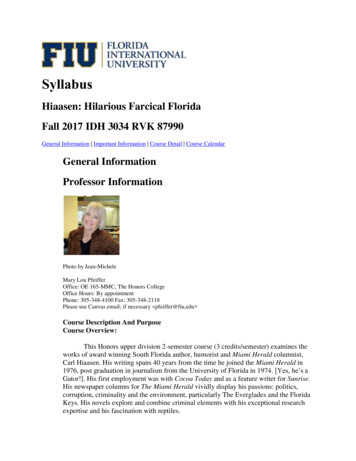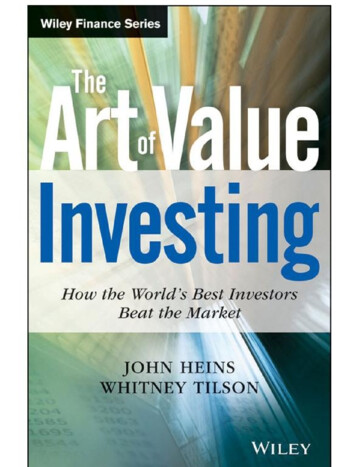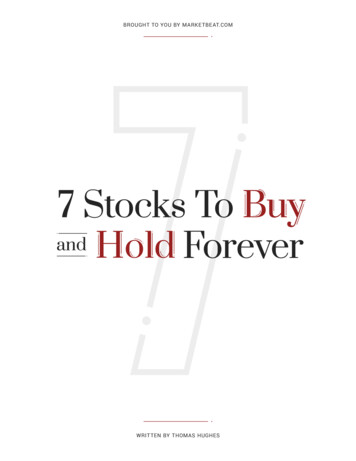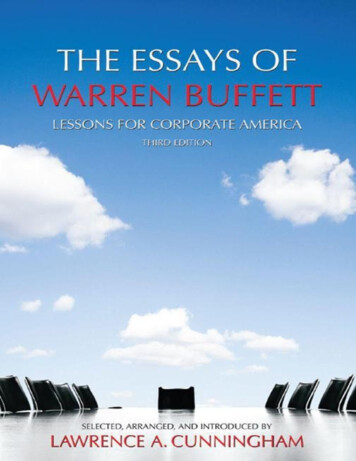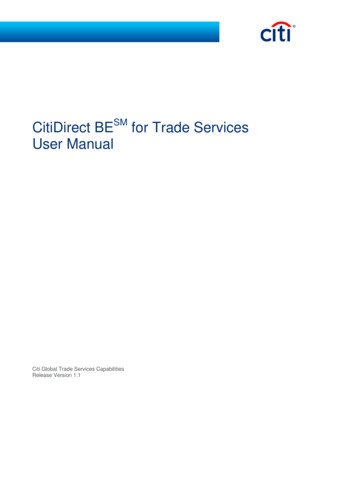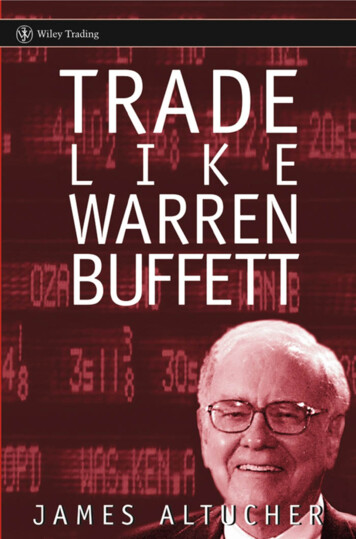
Transcription
Trade LikeWarren BuffettJAMES ALTUCHERJohn Wiley & Sons, Inc.
Trade LikeWarren Buffett
John Wiley & SonsFounded in 1807, John Wiley & Sons is the oldest independentpublishing company in the United States. With offices in NorthAmerica, Europe, Australia, and Asia, Wiley is globally committed to developing and marketing print and electronic productsand services for our customers’ professional and personalknowledge and understanding.The Wiley Trading series features books by traders whohave survived the market’s ever-changing temperament andhave prospered—some by reinventing systems, others by getting back to basics. Whether a novice trader, professional, orsomewhere in-between, these books will provide the advice andstrategies needed to prosper today and well into the future.For a list of available titles, please visit our Web site atwww.WileyFinance.com.
Trade LikeWarren BuffettJAMES ALTUCHERJohn Wiley & Sons, Inc.
Copyright 2005 by James Altucher. All rights reservedPublished by John Wiley & Sons, Inc., Hoboken, New JerseyPublished simultaneously in CanadaNo part of this publication may be reproduced, stored in a retrieval system, or transmitted in any form or by any means, electronic, mechanical, photocopying, recording, scanning, or otherwise, except as permitted under Section 107 or 108 of the 1976United States Copyright Act, without either the prior written permission of thePublisher, or authorization through payment of the appropriate per-copy fee to theCopyright Clearance Center, 222 Rosewood Drive, Danvers, MA 01923, 978-750-8400,fax 978-646-8600, or on the Web at www.copyright.com. Requests to the Publisher forpermission should be addressed to the Permissions Department, John Wiley & Sons,Inc., 111 River Street, Hoboken, NJ 07030, 201-748-6011, fax 201-748-6008.Limit of Liability/Disclaimer of Warranty: While the publisher and the author haveused their best efforts in preparing this book, they make no representations or warranties with respect to the accuracy or completeness of the contents of this bookand specifically disclaim any implied warranties of merchantability or fitness for aparticular purpose. No warranty may be created or extended by sales representatives or written sales materials. The advice and strategies contained herein may notbe suitable for your situation. You should consult with a professional where appropriate. Neither the publisher nor the author shall be liable for any loss of profit orany other commercial damages, including but not limited to special, incidental, consequential, or other damages.The statements and opinions expressed in this book are those of the author. FidelityInvestments is not responsible for the accuracy or completeness of any statementsor data contained in this book. Fidelity Investments has not examined, nor does itendorse, any trading strategy discussed in this publication.For general information about our other products and services, please contact ourCustomer Care Department within the United States at 800-762-2974, outside theUnited States at 317-572-3993 or fax 317-572-4002.Wiley also publishes its books in a variety of electronic formats. Some content thatappears in print may not be available in electronic books. For more informationabout Wiley products, visit our Web site at www.wiley.com.Library of Congress Cataloging-in-Publication DataAltucher, James.Trade like Warren Buffett / James Altucher.p. cm. — (Wiley trading series)ISBN 0-471-65584-8 (cloth)1. Investments. 2. Buffett, Warren. I. Title. II. Series.HG4521.A4559 2005332.6—dc222004020828Printed in the United States of America10 9 8 7 6 5 4 3 2 1
To Sam Vitiello and Seymour Altucher,two great fathers.
ContentsAcknowledgmentsixCHAPTER1 Does Warren Buffett Trade?1CHAPTER2 Graham-Dodd and a Dose of Fisher15CHAPTER3 Equities41CHAPTER4 Current Holdings51CHAPTER5 Merger Arbitrage Like Warren Buffett79CHAPTER6 Relative Value Arbitrage121CHAPTER7 PIPEs and High Yield129CHAPTER8 Junk143CHAPTER9 Warren Buffett’s Personal Holdings149CHAPTER 10 Closed-End Fund Arbitrage159CHAPTER 11 Interviews with Two Buffett-StyleHedge Fund Managers169CHAPTER 12 P/E Ratios, Market Timing,and the Fed Model191CHAPTER 13 Buffett and Disasters203CHAPTER 14 Life and Death221CHAPTER 15 Fixed-Income Arbitrage223CHAPTER 16 Trade Like Bill Gates229CHAPTER 17 Jealousy235Index241vii
Acknowledgmentsirst off, I would like to thank Warren Buffett for having such a richand varied career as to create the material that was then used forthis book. I hope I learned something.Dave Morrow and Jim Cramer at TheStreet.com, and Steve Schurr andLionel Barber at the Financial Times, have nurtured the environments thathave allowed me to write and interact with other investors and writers. RealMoney.com and the Financial Times have been great homes for my articlesand I’m grateful. George Moriarty, Gretchen Lembach, Aaron Task, and AdamBatchelder have had the grueling task of editing and reediting my articles atTheStreet.com and they have helped me have a lot of fun in the process.Michelle Donley, Karen Ludke, and Omid Malekan all have helped mein various stages of editing this book and all three have had no shame whentelling me which chapters and passages could be a lot better. Thanks forcreating a whole lot more work for me and I hope I can return the favorsome day!As usual, Dan Kelly has been both sounding board and psychiatristthroughout the writing and production of this book. Particular thanks forfollowing up on that bounced email to Debbie, enabling us, for once, to befooled by randomness.Special thanks to Tim Melvin for pointing out to me Buffett’s personalholdings.Michael Angelides, Neal Berger, Jay Kaplowitz, Worth Gibson, StephenDubner, Joel Gantcher, Cody Willard, and Jim Moore and too many othersto mention have all played key roles in encouraging and developing myother activities while I have been writing this book. Pamela van Giessen ofWiley has continued to be a great support and confidante throughout thisentire process and I am greatly appreciative. And finally, Anne, Josie, andMollie deserve special thanks for having put up with yet another summer ofwriting a book. I hope to make it up to them ten-fold.Fix
CHAPTER 1Does WarrenBuffett Trade?My favorite holding period is forever.—Warren Buffettirst, I have to apologize in advance. This book barely mentionsCoca-Cola or the Washington Post. I also don’t really talk about themany fine companies that Berkshire Hathaway has bought overthe past three decades (See’s Candies, the Pampered Chef, Dairy Queen,National Furniture Mart, and others). There are many excellent books thatcover these topics. And while Warren Buffett has made billions of dollarsfrom these investments, I don’t think I can add to the already great dialoguethat has taken place on these topics.Nor is this book really about value investing. There are many definitions of value investing and many treatises on value versus growth. Buteven Buffett has stated that on the whole, the distinctions between valueand growth are nonsense. This book is about the various ways that Buffetthas applied the concept of “margin of safety” outside of his buy-and-holdstrategies. He has had a longer and more diverse investment career thanjust about anybody. There are several people in the world (fewer than ten,actually) who have had more years’ experience than Buffett at pickingstocks, but I can think of no one who has traded and invested with a moreF1
2TRADE LIKE WARREN BUFFETTdiverse group of strategies over the past fifty years. It is these strategiesthat I write about. Many of them are normally thought of as “trading” strategies instead of the buy-and-hold investing for which Buffett is famous.When I went to the Berkshire Hathaway annual meeting in 2003 I hadno idea what I would encounter. I met one man who bought 200 shares ofBerkshire Hathaway in 1976 for 15,000, give or take. He sold half of thoseshares a year later for a solid double (who can blame him?) and today theremaining shares are worth over 9,000,000. He now hangs out skiing inTahoe for most of the year.I asked him why he had bought those shares and he said that he hadheard of Warren Buffett while growing up in the same town as him, had heardhe was smart, and liked the insurance industry. One can argue that this manI had spoken to was an incredible investor. He had turned 15,000 into 9,000,000 over the course of 25 years—a 50,000 percent return!Not everyone at the meeting was as lucky. Most of the people at themeeting were fairly recent owners of their shares and were either mildly upon their investment or flat. At the time of this writing Berkshire Hathawayis close to making an all-time high, so hopefully most of these people haveheld onto their shares. Throughout the meeting I asked people why theywere there. After all, it was the most popular annual meeting in the company’s history, with approximately 15,000 people in attendance. Some people were there because they just wanted to see Warren Buffett. Whatzeitgeist had he been tuned into all his life that he could start with 100 andcompound it into 40 billion? While at the same time maintaining his homespun humility and simple lifestyle (he still lives in the same house he bought40 years ago for 30,000).Buffett supposedly found these incredible deals through the principlesof value investing. Again, there are many good books out there about valueinvesting that try to explain Buffett’s value approach.1 At the end of this1The most famous of the books is Robert G. Hagstrom’s The Warren Buffett Way:Investment Strategies of the World’s Greatest Investor. Others include How to PickStocks Like Warren Buffett: Profiting from the Bargain Hunting Strategies ofthe World’s Greatest Value Investor by Timothy Vick and How to Think Like BenGraham and Invest Like Warren Buffett by Lawrence Cunningham. All of these aregood books that focus on investing in companies with solid management, good corporate governance, high return on equity, a good brand, and so on.
Does Warren Buffett Trade?3book I try to provide a comprehensive suggested reading list of the majorbooks written about Buffett.However, Buffett achieved much of his early success from arbitragetechniques, short-term trading, liquidations, and so on rather than using thetechniques that he became famous for with stocks like Coca-Cola or CapitalCities. In the latter stages of his career he was able to successfully diversifyhis portfolio using fixed income arbitrage, currencies, commodities, andother techniques. And further, in his personal portfolio he tended to stick tothe style of deep value investing that marked his early hedge fund years.This book is titled Trade Like Warren Buffett, and the phrase alonebrings up several contradictions in the traditional mythos about Buffett.First, Warren Buffett supposedly does not trade. He finds an undervaluedgem, then buys and holds onto it forever. After all, it takes a million yearsto turn a piece of coal into a diamond, and a good company should alwaysbare that in mind. For example, Buffett bought Gillette in the 1980s and, to hiscredit, many multiples later, he still holds onto it. After all, people willalways shave, so the demographic for Gillette is approximately 3,000,000,000citizens of this planet. How can you go wrong holding this stock forever?Exhibit 1.1 represents the holding period of some of the BerkshireHathaway trades that Buffett held for less than five years.Second, the world of trading usually evokes images of day traders, fingers on the trigger, ready to scalp stocks for a few ticks several dozen timesa day. Seldom do people think of Warren Buffett, known for holding ontostocks for years, when the subject of day trading comes up.However, the texture of value investing now is very different than whenWarren Buffett was making his early profits, let alone when BenjaminGraham and David Dodd wrote their classic text Security Analysis. Backthen, there was only a limited set of eyes that had the access to information,not to mention the desire, to locate companies that fit a certain deep valuecriterion. But today if I want to sift through six thousand stocks to findsome that fit specific earnings, ROE (Return on Equity), P/E (price overearnings ratio), and other criteria, then I can easily do so with any numberof stock screeners online. And, believe me, countless value investors aredoing just that. The information arbitrage that existed in the 1960s and earlier is nearly nonexistent today.Buffett would spend hours going through Moody’s reports on each stock,sifting for the gold among the dirt. And, after spending hundreds of hours
4EXHIBIT 1.1TRADE LIKE WARREN BUFFETTSome Berkshire Hathaway Trades Held for Less Than 5 YearsCompanyKaiser AluminumSAFECORJ ReynoldsTimeGuinnessKnight-RidderABCFW WoolworthALCOAPinkerton’sCleveland-Cliffs IronGeneral DynamicsCapital CitiesKaiser IndustriesAmerada HessNational DetroitTimes MirrorNational StudentMarketingArcataGATXCrum & ForsterExxonNorthwest IndustriesBeatriceLear SieglerGannettPNC BankMcDonald’sTravelersYear ofPurchaseTime Held(Years)Metals and gBroadcastingRetailMetals and MiningProfessional ServicesMetals and MiningAerospaceBroadcastingMetals and 22222211111Financial erospacePublishingBankingRestaurantsFinancial 961997111111111111Industrydoing that (an activity that might now take one hour, tops), he would have tothen figure out how to actually buy the shares he wanted. For instance, whenBuffett was trying to buy shares of Dempster Mining he had to drive to thetown where they were based and convince locals to sell their shares to him.There was no liquid market out there like there is now. So when he boughtthe shares, he had to hold them for longer then he might have wanted to.So, value investing the way Buffett and Graham practiced it no longerexists today. There are thousands of mutual funds and hedge funds com-
Does Warren Buffett Trade?5peting for those arbitrage opportunities, not to mention retail investorswith access to the Internet.During Buffett’s hedge fund years (between 1957 and 1969) there weresome years in which more than half his profits came from what he called“workouts”—special situations, merger arbitrage opportunities, spin-offs,distressed debt opportunities, and so on. Playing with semantics, we canargue that all of those opportunities represented “value”—that is, buyingsomething that is cheaper than what it was worth—whether it was aspread between two securities, a distressed bond, or a stub stock thateveryone ignored. However, these situations are not usually described asvalue investing.Instead, over the past two decades we have seen Buffett dip his investing prowess into commodities (his foray into silver in 1997), fixed incomearbitrage, many instances of distressed debt through the use of privateinvestment in public equity (PIPE) vehicles, merger arbitrage, relativevalue arbitrage, and so on. In addition, Buffett has made his first foraysinto technology investing, owning over the past few years a number ofshares in telecommunications services company Level Three and the debtof e-commerce company Amazon; the latter is a company that had neverproduced a dime of earnings when Buffett first invested in it, let alone aneasy means by which someone could compute future cash flows.There are three stages to Buffett’s investment career, and we will focuson techniques used inside each of those phases.THE EARLY YEARSBuffett’s hedge fund years were when he built his fortune from essentially nothing to about 25 million at the time he was interviewed by AdamSmith for his 1971 classic, SuperMoney. During this time Buffett had threetechniques:1. The cigar butt technique, into which category Berkshire Hathaway (inits original form) fell. This meant buying stocks that were selling forless than tangible assets. Buffett would sometimes accumulate enoughshares that eventually a change of control would occur, giving himdirect power over how the assets of the company would be disposed.
6TRADE LIKE WARREN BUFFETT2. Value investing, but combined with some of his partner CharlieMunger’s ideas on growth and the potential of brands. This resulted inBuffett’s American Express play, among others.3. Special arbitrage situations, workouts, distressed debt, merger arbi-trage, spin-offs, and so on.THE MIDDLE YEARSThe 1970s and 1980s were the decades when Buffett made the full transition from successful hedge fund manager to operator, asset allocator, andinsurance company magnate. Why the insurance business? And why did heleave the hedge fund business? We know now in retrospect that he was avery good market timer, although prone to being early, just as BernardBaruch said, “I always sold too soon.” So it could be argued that Buffett’sdeparture from the hedge fund business right before an essentially flatdecade was a sign of good market timing. However, I don’t believe this.I believe that Buffett did anticipate a potentially horrendous decade forstock market returns, and in fact, 1973–74 was the worst downturn sincethe 1930s. But I don’t think that Buffett would have stopped his hedge fundfor fear of poor market returns. Rather, he was always more enthusiastic inhis annual letters to his partnership investors when the market was doingits poorest. He prided himself more on outperformance than absoluteperformance. A return of 20 percent in a year when the market was up30 percent would have been a disaster for him. Far better would be toreturn five percent, with the market returning 20 percent for the year. Sothe fact that the market was about to make a strong downturn would nothave been the impetus to cause him to wind down his hedge fund and gointo the insurance business.Rather, I think he saw an opportunity unlike any he had encountered inthe past and he wanted to pounce on it. The way Buffett’s partnership wasstructured, he took a 0 percent management fee and 25 percent of all profits. As an example, if his fund had 5 million in it and he returned 20 percent, or 1 million, for his investors, then he would take 25 percent of that,or 250,000 of that, as his fee.However, an insurance company is much more attractive to a masterasset allocator like Buffett. An insurance company works like a hedge fund
Does Warren Buffett Trade?7except Buffett gets to keep 100 percent of the profits. People “invest” theirmoney when they pay their premiums and only get to take their money outagain upon illness or disaster. In a well-run insurance business the “cost offloat” is ideally zero; that is, you spend no more in payouts than you take inpremium. In this way, all profits go to the owners of the business. If the costof float is zero, then the economics of the insurance business are much better than the economics of a hedge fund.Rather than retire to a lifetime of bridge playing, Buffett ended upbuying for 40/share most of the Berkshire Hathaway shares that he hadoriginally bought for his investors (profitably for them at prices rangingfrom 7 to 16 per share). Then, while Buffett used Berkshire as his base,the rest of the 1970s became a rollup of insurance companies, regionalbanks, and other cash-producing assets ranging from the Nebraska Furniture Mart to See’s Candies.It was during this period that he became less focused on his workoutplays and more focused on his “control” plays like the insurance companies, furniture companies, and chocolate companies he was buying and his“generals”—the big value plays like Coco-Cola and Gillette that ultimatelycreated billions of dollars in investment profits for Berkshire.There is no one way to sum up Buffett’s investment style during thisperiod. Early on, he was certainly interested in buying companies for lessthan their book value. The Washington Post is a great example, where hebegan accumulating shares at a fraction of their liquidation value. Later on,however, particularly in the 1980s, his methods were much less quantitativeand bordered on highly subjective. A case in point is Coca-Cola, which Buffett began accumulating in 1988; he ultimately became the largest shareholder. Coke was trading at 13 times earnings, hardly a discount to themarket at that time, which was trading around 10 times forward earnings.That said, Buffett was convinced, and he was right, that Coke was tradingat a huge discount based on the future earnings of the company.“The Middle Years” are perhaps the least interesting period for me.However, this period (the 1970s and 1980s) is the subject of countlessbooks on Buffett. Hagstrom’s book The Warren Buffett Way2 set the toneand documents Buffett’s stock picks during this period.2The Warren Buffett Way, Robert Hagstrom (Wiley, 1993).
8TRADE LIKE WARREN BUFFETTI repeat the following refrain throughout the book: It is not possibleto trade exactly like Warren Buffett. The goal is to use whatever meanspossible to approximate his trading by attempting to quantify the term“margin of safety”.THE LATER YEARSThe 1990s and then the 2000s created an interesting dilemma for Buffett,one that no other company has ever faced. He simply had too much cash toput to work. As much as he loved finding quality companies and stocks, theworld was just too small for him at this point. In lectures that he occasionally gave to college students he would often sentimentally reflect that if hehad less money he could still return 50 percent a year in arbitrage situations. But with 50 billion to put to work this was just impossible. Nor is iteasy to go through the market and find the slim pickings. Let’s say a 1 billion company is trading at a cheap price and Buffett is able to buy 10 percent of it. Assume that it then goes up 100 percent for him over the nextyear—a truly remarkable return. It would still only increase the book valueof Berkshire Hathaway by 0.2 percent.Instead, the 1990s saw several trends developing in Buffett’s style. Firstthere was a flight to safety. In the late nineties, when the world was haphazardly buying everything with dot-com written all over it (author disclosure: I was, too), Buffett was diversifying into bonds, into silver, fixedincome arbitrage, and ultimately foreign currencies.So given the fact that Buffett’s investment career has spanned fivedecades and multiple styles and disciplines, is it possible to “trade likeWarren Buffett”?IT’S TOO LATEIt is not possible to trade exactly like Warren Buffett. The best we can do isapproximate his approach, plead in each trading situation for the margin ofsafety that Buffett always demands, and try to develop our own approachesthat are, if not exact replicas, at least Buffett-like. But why can’t we tradelike him? To summarize the three main reasons:
Does Warren Buffett Trade?91. The Internet has changed everything. Every SEC filing, every newsreport, every inside transaction, and every earnings release is instantlyposted to the Internet and available to the tens of thousands of investorswho are looking for low price to book, high return on equity companies.Although many studies have come to the conclusion that too many retailinvestors are naive, the reality is that there are many good investors outthere who know how to make use of the information at their fingertips.No longer does an investor have to dig through tattered old filings tofind the next Dempster Mining and then drive around Nebraska to findrandom shares in it.2. Arbitrage spreads have narrowed. The “workout” trades that Buffettmastered in his hedge fund days are no longer as easy to accomplish asthey once were. When Buffett started out, only a handful of hedge fundsexisted that were attempting to use those techniques. Now there areover 7,000 hedge funds trying to squeeze the blood out of every arbitragesituation. While the opportunities still exist—opportunities that we willexamine in depth in later chapters—they are of a much different breedthen what Buffett first encountered.3. People don’t give us money. Warren Buffett has enormous deal flow.Every day opportunities are placed in front of him, and often the typesof deals are not those that are available to the average investor. Theflipside to this is that he also has a lot of bad deals put in front of him,and it takes acumen to sift through these questionable opportunities tofind the gems. However, his gems might be 10-carat diamonds, whereasthe average investor needs to settle for a few inclusions and work hisor her way up from there.IT’S NOT TOO LATEBut don’t despair. The key thing to focus on is Buffett’s constant desire fora margin of safety. With each style of investing that he delves into, he consistently requires a certain degree of safety; investors who attempt to applyhis techniques should do the same. Also, the average investor has severaladvantages over Warren Buffett, both the Buffett from his early hedge fundyears and the Buffett of the 1990s and 2000s.
10TRADE LIKE WARREN BUFFETT1. The Internet. The same phenomenon that was listed as a disadvantageabove is also an advantage. The reality is that it is easier to research anyinvestment possibility under the sun. It is also easier to quantify andback-test various approaches to verify that an approach has at leastbeen statistically sound in the past. Buffett has a great appreciation forthe quantifiable side of investing; it would be interesting to see what hecould have done had he had the capabilities of the Internet behind himwhen he started.2. Size is important. Buffett is simply too big. He cannot enter into aposition easily without causing the entire world to react accordingly.For instance, when he started buying up silver he wasn’t simply making a small investment. He ended up becoming the largest investor insilver since the Hunt Brothers, controlling not just a small amount, but25 percent of the entire world’s above-ground supply. And still thiswas just a tiny, miniscule drop in the bucket for the Berkshire Hathaway portfolio. Getting into and then out of this market was no easytask for Buffett either. Silver, which had been in a slump for years,jumped 30 percent when it was discovered that Buffett was makingan investment.No wonder Buffett likes to tell people to buy and hold. If investorsfeel like selling something that Buffett owns, there is almost zerochance Buffett can get out before the other interested sellers do.Clearly, if everyone had a philosophy of “buy and hold forever,” itwould be much better for Buffett’s investments, since he can’t reallysell. The reality is that during his career he has done much selling andhas held even some core value plays (McDonald’s and Disney are greatexamples) for short periods of time.The fact that the average investor is much more nimble is a hugeadvantage, although it is an advantage that cannot be treated lightly dueto the damage it can cause. Many studies have been done that show thatthe average retail investor is damaged by too high a turnover in his or herportfolio. Ultimately, though, it is better to have the option than to nothave it at all.The remainder of this book is mostly broken down by investment style.
Does Warren Buffett Trade?11THE INVESTMENT STYLESMerger ArbitrageBuffett made significant use of merger arbitrage (buying the stock of a company being acquired and selling short the acquirer) in his hedge fund daysfrom 1957 to 1969. As recently as the 1998 Berkshire Hathaway conferencehe stated that if he only had a small amount to play with he could still earn50 percent a year using merger arbitrage techniques.Relative Value Arbitrage“Relative value” is a catch-all phrase that takes advantage of any discrepancy between the spread in values between two assets. A great example(which Buffett did not play as far as I know) was when 3COM (Nasdaq:COMS) spun out Palm (Nasdaq: PALM) and the shares 3COM owned inPALM were worth significantly more than the entire market cap of 3COM.Buying 3COM and shorting PALM was a straightforward exploitation ofthat discrepancy and had a fair amount of margin of safety associated withit. Of course, the spread could get worse before it gets better. For example,Eifuku, a hedge fund in Japan that was wiped out in less than two weeks in2003 from applying these techniques), but hey, that’s what makes it somuch fun.BondsBuffett has spoken several times over the past 40 years about the meritsof the Federal Reserve model in market timing. More recently, when theeconomy was slowing and the market was getting significantly overvaluedrelative to interest rates, Buffett made the impressive move of switching hisportfolio so he was heavily weighted in bonds. Masterfully, he did this without incurring any tax penalty at all (that is, he didn’t have to allocate out ofstocks and into bonds).We will look at the merits of various applications of the Fed model andsome studies that have been done in this area; included in this book areinterviews with several managers who focus on investing in bonds.
12TRADE LIKE WARREN BUFFETTFixed Income ArbitrageAs much as Buffett has a distaste for derivatives and leverage, he does diphis toes into the world of fixed income arbitrage, the idea of buying andselling different interest rate derivatives with different time payoffs. Whatis fixed income arbitrage, how does Buffett invest in it, what are theadvantages and disadvantages? While this is normally considered a verysolid and safe way to invest, it should be pointed out here that Long-TermCapital Management, the highly pedigreed hedge fund that lost billion ofdollars in 1998, also felt this was a very safe way to invest the money oftheir investors.StocksI didn’t want this to be a book “like all the others,” and most other booksabout Warren Buff
Altucher, James. Trade like Warren Buffett / James Altucher. p. cm. — (Wiley trading series) ISBN 0-471-65584-8 (cloth) 1. Investments. 2. Buffett, Warren. I. Title. II. Series. HG4521.A4559 2005 332.6—dc22 2004020828 Printed in the United States of America 10 9 8 7 6 5 4 3 2 1 f
